Arizona is a birder’s paradise. The state is a well-known destination for bird enthusiasts. More bird species have been recorded in Arizona than in any other state. This is no surprise when you think about Arizona’s wide range of habitats, including inland marshes, canyonlands, alluvial river floodplains, forested mountains, grassy plains and hills, and deserts.
Arizona is home to several different species of hawk, making this state a must-visit destination for anyone who wants to experience an unforgettable birding tour. These raptors are widely distributed in different habitats. They can be found in open fields, rocky places, mountains, cliffs, and even wetlands, where they can easily find prey.
Here’s a look at eight different species of hawks you can find in Arizona.

Now read on to find out more information about these hawks, their sizes, and their behaviors.
1. Red-tailed Hawk
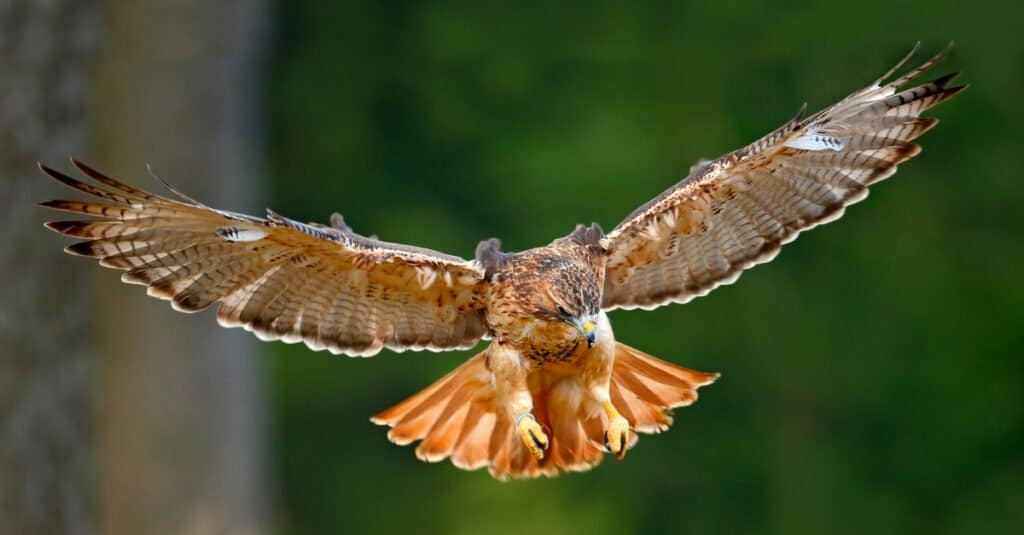
Red-tailed hawks have an incredible vision that helps in hunting for prey.
©Ondrej Prosicky/Shutterstock.com
| Red-tailed Hawk | |
|---|---|
| Scientific name | Buteo jamaicensis |
| Weight | 1.5-3.5 lbs (680-1586 g) |
| Height | 18-26 in (45-65 cm) |
| Wingspan | 43-56 in (110-141 cm) |
Red-tailed hawks are the most common raptors in Arizona. They derive their name from their wide red tails. They are giant hawks with broad, rounded wings that are rich brown on top and pale underneath.
These hawks feed on rattlesnakes, mice, lizards, rabbits, voles, rats, and smaller birds. They have an incredible vision that helps in hunting for prey. Red-tailed hawks are susceptible to predation by humans, great-horned owls, and bobcats.
Red-tailed hawks build their nests in the crowns of tall trees. Females lay 1-4 eggs and incubate them for about 28 to 35 days.
2. Broad-winged Hawks
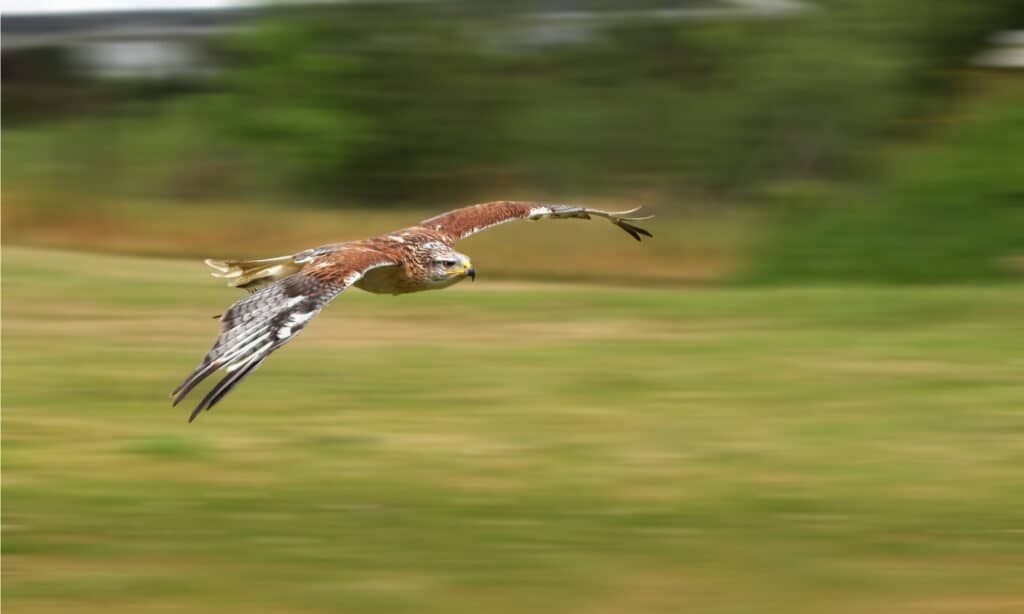
During the breeding season, broad-winged hawks perform courtship dances for their mates.
©pr2is/Shutterstock.com
| Broad-winged Hawks | |
|---|---|
| Scientific name | Buteo platypterus |
| Weight | 9.3-19.8 oz (264-561 g) |
| Height | 13.4-17.3 in (34-44 cm) |
| Wingspan | 31.9-39.4 in (81-100 cm) |
Broad-winged hawks are medium-sized birds of prey that are often sighted in Arizona. They have scissor-like beaks to tear their prey, sharp talons to kill their prey, and solid vision to spot their prey.
In spring, broad-winged hawks can be found around the Grand Canyon and other forested areas where they can hunt for rodents, frogs, lizards, birds, insects, and other small mammals.
During the breeding season, these hawks perform courtship dances for their mates. Females lay between 1 and 5 eggs, which take around 28 days before they hatch. They protect the chicks for five to six weeks in the nests until they are ready to fly.
3. Ferruginous Hawk
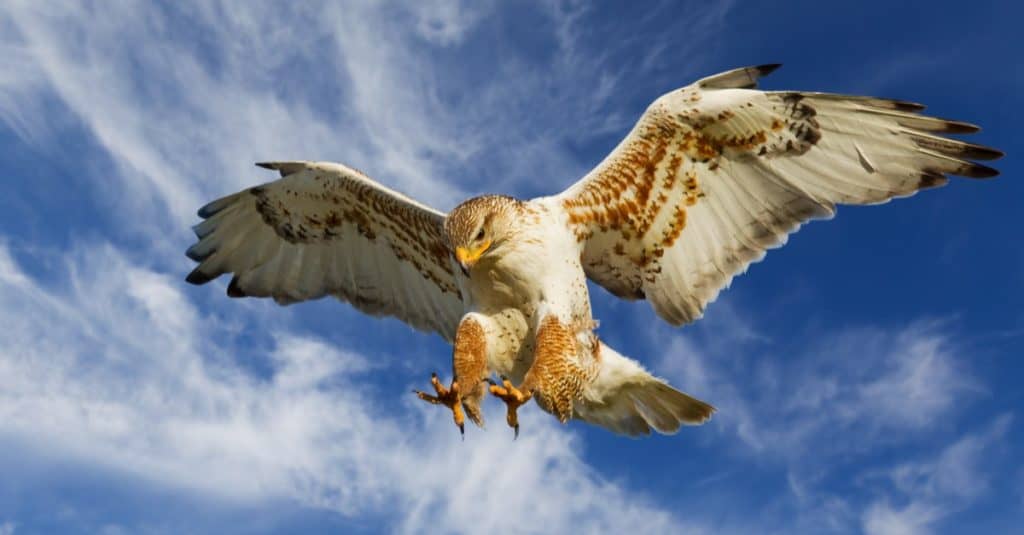
The ferruginous hawk’s diet consists of mice, grasshoppers, beetles, birds, rats, ground squirrels, and black-tailed rabbits.
©Stephen Mcsweeny/Shutterstock.com
| Ferruginous Hawk | |
|---|---|
| Scientific name | Buteo regalis |
| Weight | 32 to 80 oz (907 to 2,268 g) |
| Height | 20 to 27 in (51 to 69 cm) |
| Wingspan | 52-56 in (133-142 cm) |
Ferruginous hawks are the largest hawks in Arizona in terms of body length and weight. They are often mistaken for eagles, and the females are larger than the males. Ferruginous hawks can be spotted throughout the year in Arizona.
They hunt for small-to-medium-sized animals, and their diet consists of mice, grasshoppers, beetles, birds, rats, ground squirrels, and black-tailed rabbits, among many other small mammals. They also hunt small reptiles such as bull snakes and garter snakes.
Ferruginous hawks build their nests in open spaces where the female lays 3-5 eggs and takes about 32 days to hatch. The male hawks also help in the incubation and brooding of the hatchlings until they learn how to fly at around 5– 6 weeks.
4. Cooper’s Hawk

Cooper’s hawks are medium-sized birds of prey that inhabit the woodlands and forested areas in Arizona.
©Richard G Smith/Shutterstock.com
| Cooper’s Hawk | |
|---|---|
| Scientific name | Accipiter cooperii |
| Weight | 7.8-14.5 oz (220-410 g) |
| Height | 14-20 in (35-50 cm) |
| Wingspan | 24-39 in (62-99 cm) |
Cooper’s hawks are medium-sized birds of prey that inhabit the woodlands and forested areas in Arizona. One can also find them in river grooves and also in urban areas. They hunt by stealth and are the most skillful fliers.
Their diet consists mainly of small birds, insects, mice, ground squirrels, chipmunks, and snakes. Cooper’s hawks are easy prey for raccoons, great-horned owls, American crows, and large hawks.
Females lay 3 to 5 pale blue-whitish eggs, which they incubate for 32 to 36 days. The male feeds the female during the incubation and brooding period. The young ones take about 4-5 weeks to fly.
5. Rough-Legged Hawk
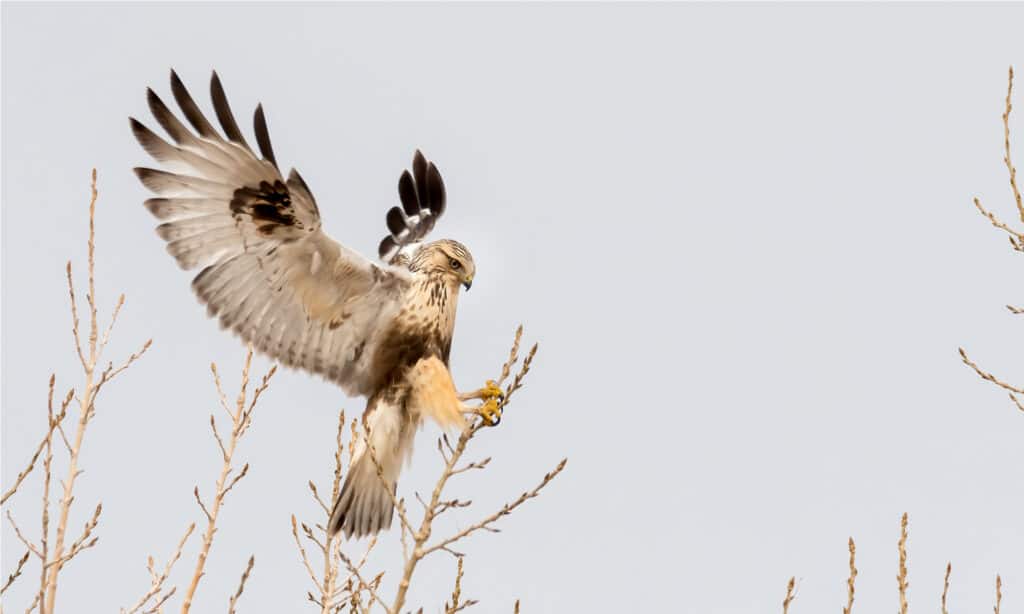
Rough-legged hawks mostly build their nests in tundra regions.
©Eivor Kuchta/Shutterstock.com
| Rough-Legged Hawk | |
|---|---|
| Scientific name | Buteo lagopus |
| Weight | 1.32-3.66 lbs (599-1660 g) |
| Height | 18-24 in (46-60 cm) |
| Wingspan | 52-54 in (132-138 cm) |
Rough-legged hawks are moderately large raptors with broad wings. Their legs are fully covered with feathers, making them well adapted for cold climates. They are often spotted in Arizona during the winter.
These hawks like to hunt on open fields. They mainly prey on rodents such as voles and lemmings. Small birds, insects, mice, rats, muskrats, and black-tailed rabbits also supplement these hawks’ diets. Predation is mainly on the young ones by bears, wolves, and foxes.
Rough-legged hawks mostly build their nests in tundra regions. Females lay up to seven eggs. Incubation takes a minimum of 31 days, and after hatching, the young ones stay with their parents for 4-6 weeks before leaving the nest.
6. Northern Goshawk

Northern goshawks prefer nesting in deciduous or coniferous forests during breeding seasons.
©Milan Zygmunt/Shutterstock.com
| Northern Goshawk | |
|---|---|
| Scientific name | Accipiter gentilis |
| Weight | 1.4-4.8 lbs (635-2177 g) |
| Height | 18-27 in (46-69 cm) |
| Wingspan | 40-46 in (103-117 cm) |
Northern goshawks are found in Arizona throughout the year. They are the largest of the accipiters. They have long tails and broad, rounded wings. They are grayish dark on top and pale gray underneath.
These hawks are compelling and stealthy predators. They hunt in different woodland habitats for doves, jackrabbits, squirrels, snakes, fish, voles, mice, rats, and other small mammals that they come across.
Northern goshawks are monogamous. They prefer nesting in deciduous or coniferous forests during breeding seasons. Females lay between 2 and 4 pale bluish eggs, and the incubation period takes about 28-37 days.
7. Harris’s Hawk
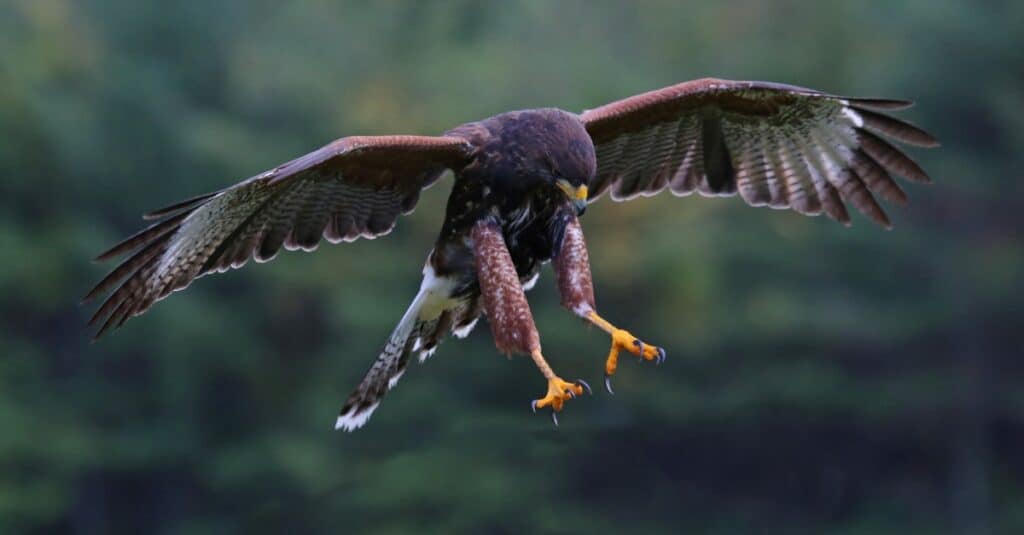
Harris’s hawks are prone to predation by great-horned owls, eagles, and coyotes.
©iStock.com/ca2hill
| Harris’s Hawk | |
|---|---|
| Scientific name | Parabuteo unicinctus |
| Weight | 18-31 oz (515-880 g) |
| Height | 18 to 23 in (46-59 cm) |
| Wingspan | 41 to 47 in (103 to 120 cm) |
Harris’s hawks are large birds of prey with long legs that can be sighted roaming around the urban and suburban areas in Arizona. They are easily identifiable due to their color and broad wings. They are very social birds that hunt in groups.
These hawks feed on half-grown wild turkeys, pocket gophers, kangaroo rats, lizards, and other small mammals. They can also take down larger animals like rabbits, mainly because they hunt in groups. Harris’s hawks are prone to predation by great-horned owls, eagles, and coyotes.
These raptors build their nests in shrubby growth and small trees in the open fields. Females lay up to 4 eggs that hatch in about 31 to 36 days after incubation. The chicks begin to fly in 38 days.
8. Zone-Tailed Hawk
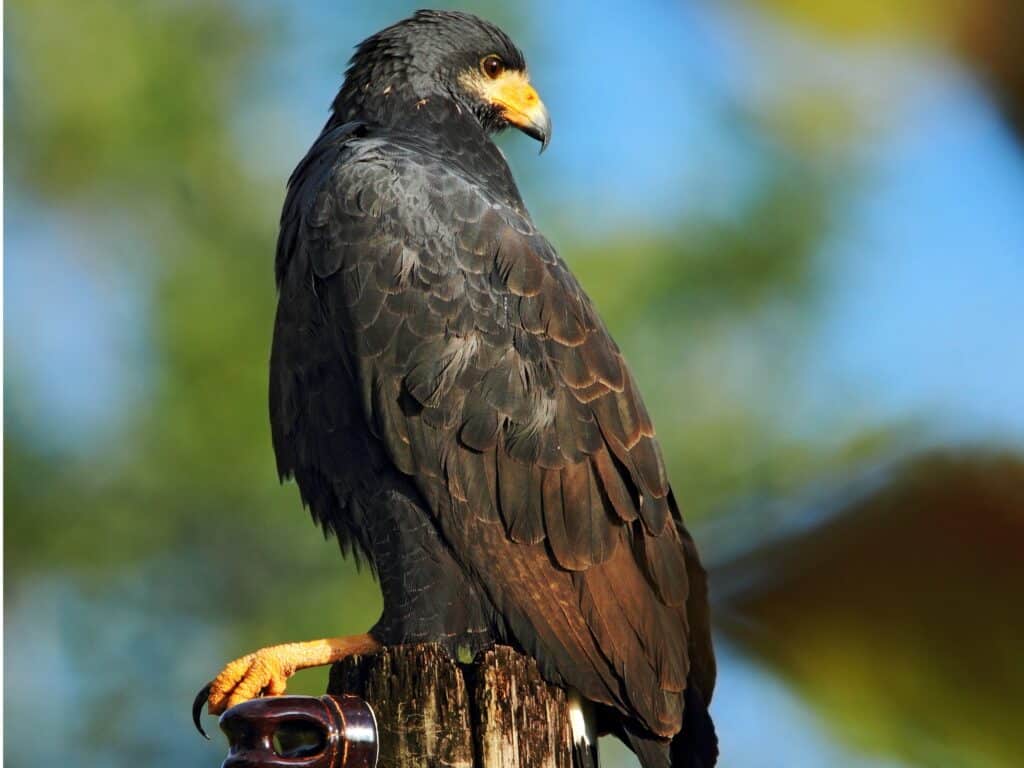
Zone-tailed hawks are incredible medium-sized raptors that can easily adapt to any environment.
©iStock.com/Ondrej Prosicky
| Zone-Tailed Hawk | |
|---|---|
| Scientific name | Buteo albonotatus |
| Weight | 1.25–2.38 lbs (565–1,080 g) |
| Height | 18 to 22 in (45-56 cm) |
| Wingspan | 46–55 in (117-140 cm) |
Zone-tailed hawks are incredible medium-sized raptors that can easily adapt to any environment. They spend most of their time in open fields, hunting for lizards, quails, chipmunks, frogs, fish, and other small mammals.
During the mating season, they build their nests in the crotch of tall trees, where the female lays between 1 and 5 white eggs with brown marks. The incubation period takes around 35 days. The young ones fledge from 7 weeks.
Summary of 8 Types of Hawks in Arizona:
| Name | Habitat | Prey |
|---|---|---|
| Red-tailed Hawk | Comfortable in any habitat. | Rattlesnakes, mice, lizards, rats, rabbits, voles, and smaller birds. |
| Broad-winged Hawk | Near the Grand Canyon and other forested areas, in spring. | Rodents, frogs, lizards, birds, insects, and other small mammals |
| Ferruginous Hawk | Open, arid grasslands; prairie; and shrub steppe country. | Mice, grasshoppers, beetles, birds, rats, ground squirrels, and black-tailed rabbits, among many other small mammals. |
| Cooper’s Hawk | Woodlands, forested areas, river grooves, and urban areas. | Small birds, insects, mice, ground squirrels, chipmunks, and snakes. |
| Rough-Legged Hawk | Hunt on open fields; build nests in tundra region. | Rodents such as voles and lemmings. Small birds, insects, mice, rats, muskrats, and black-tailed rabbits |
| Northern Goshawk | Woodlands; nest in deciduous or coniferous forests. | Doves, jackrabbits, squirrels, snakes, fish, voles, mice, rats, and other small mammals. |
| Harris’s Hawk | Urban and suburban areas; build nests in shrubby growth and small trees in open fields. | Young wild turkeys, pocket gophers, kangaroo rats, lizards, and other small mammals. |
| Zone-tailed Hawk | Can adapt to any habitat but mostly open fields. | Lizards, quails, chipmunks, frogs, fish, and other small mammals. |
The photo featured at the top of this post is © Eivor Kuchta/Shutterstock.com
Thank you for reading! Have some feedback for us? Contact the AZ Animals editorial team.






